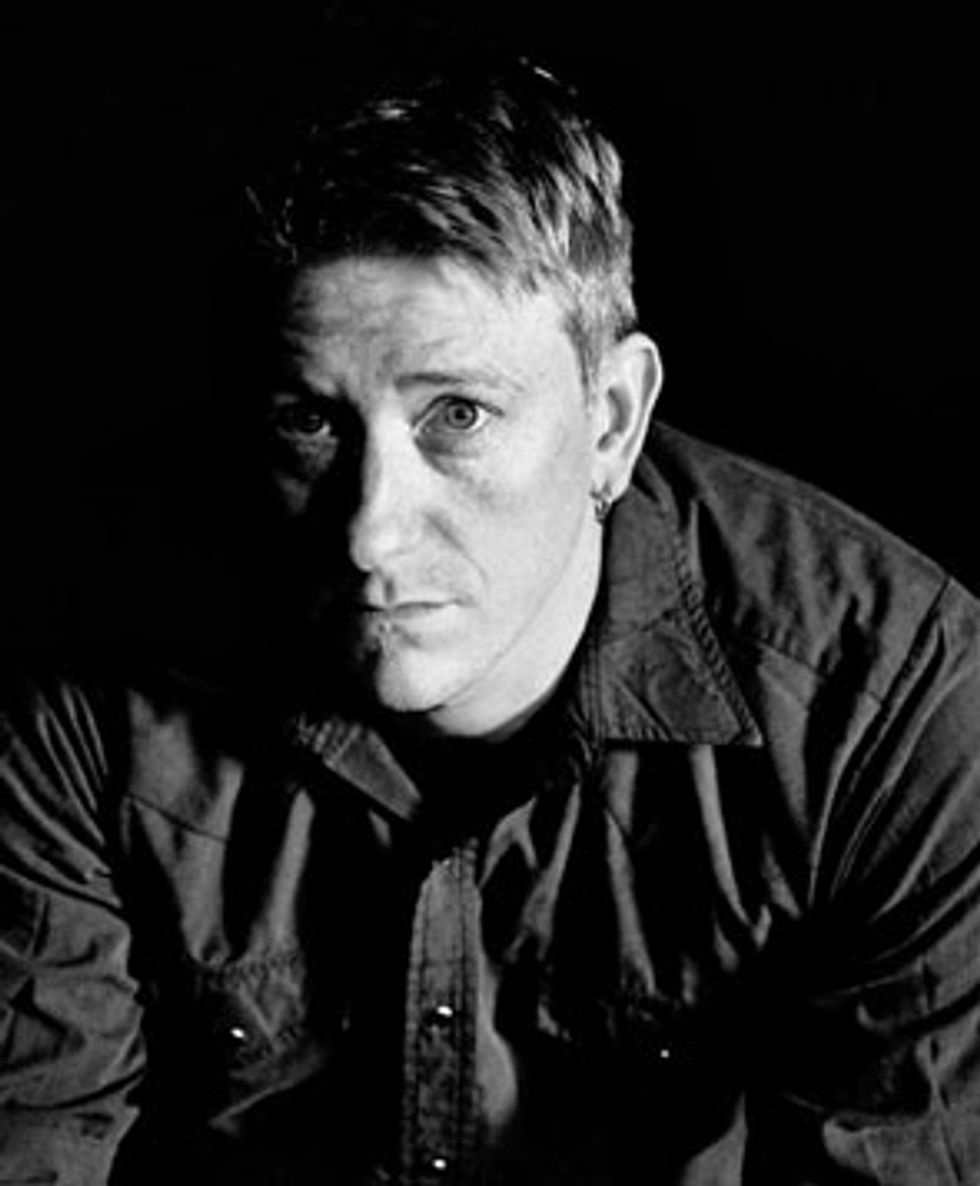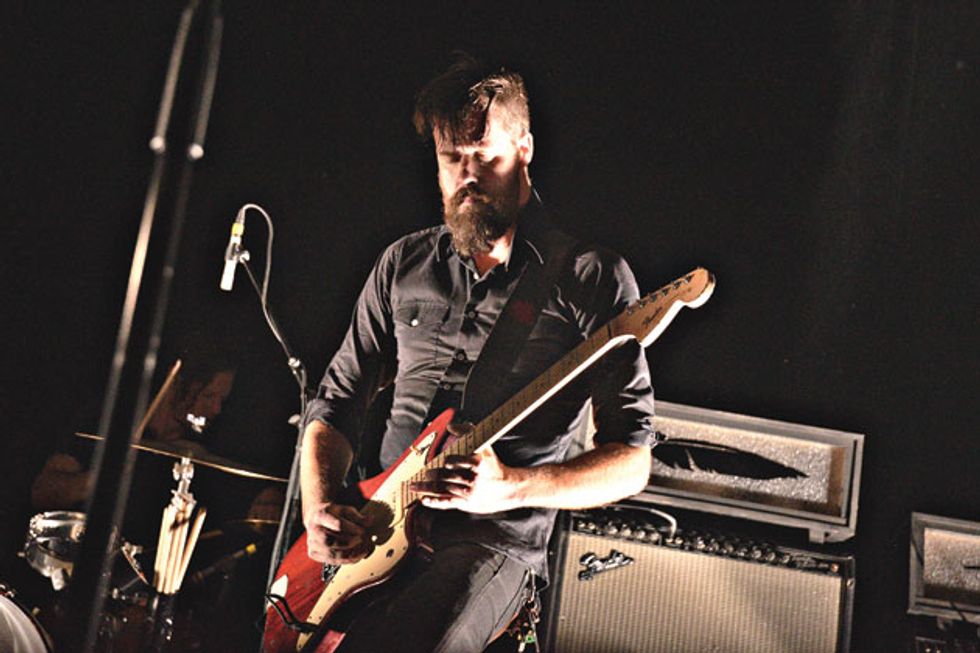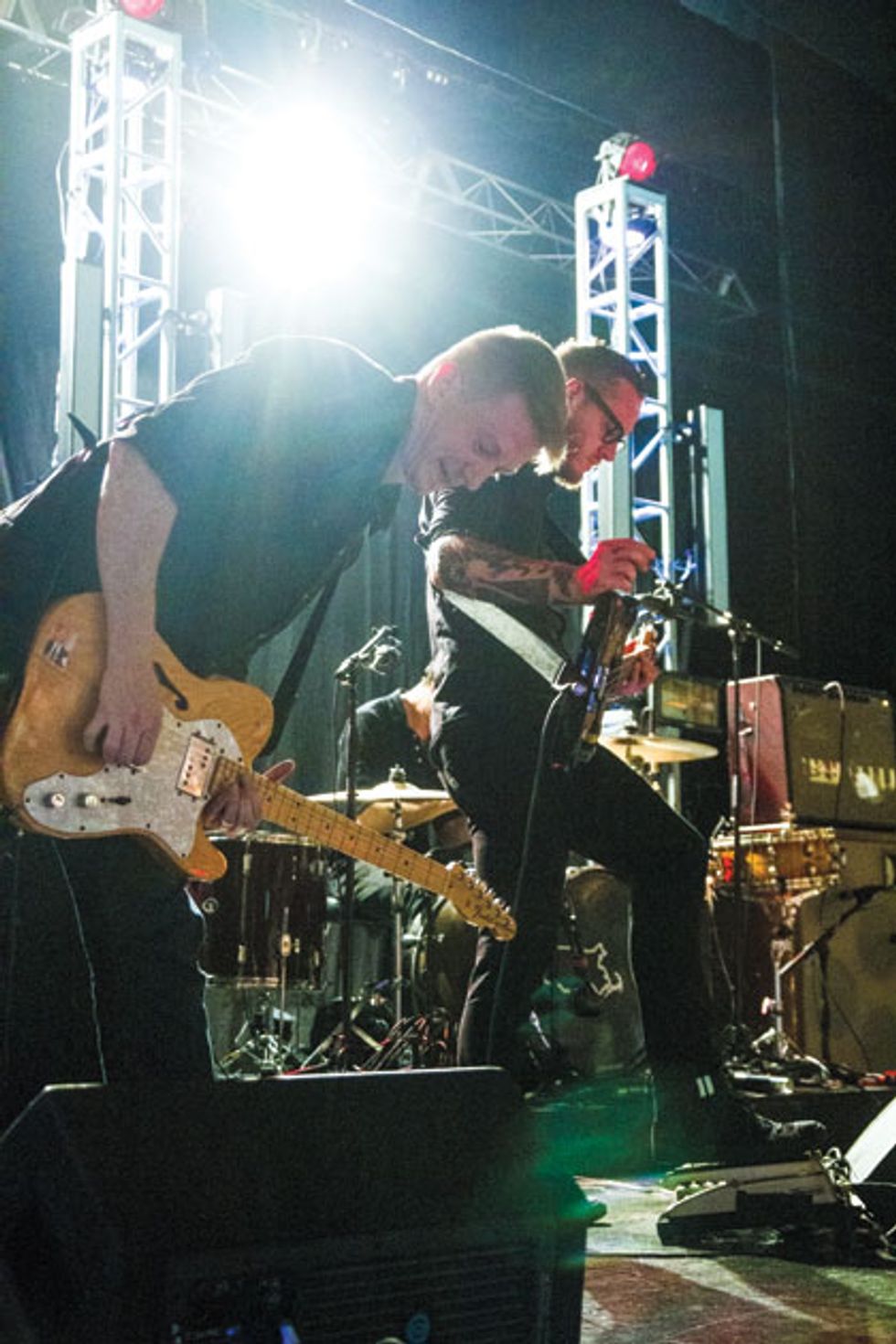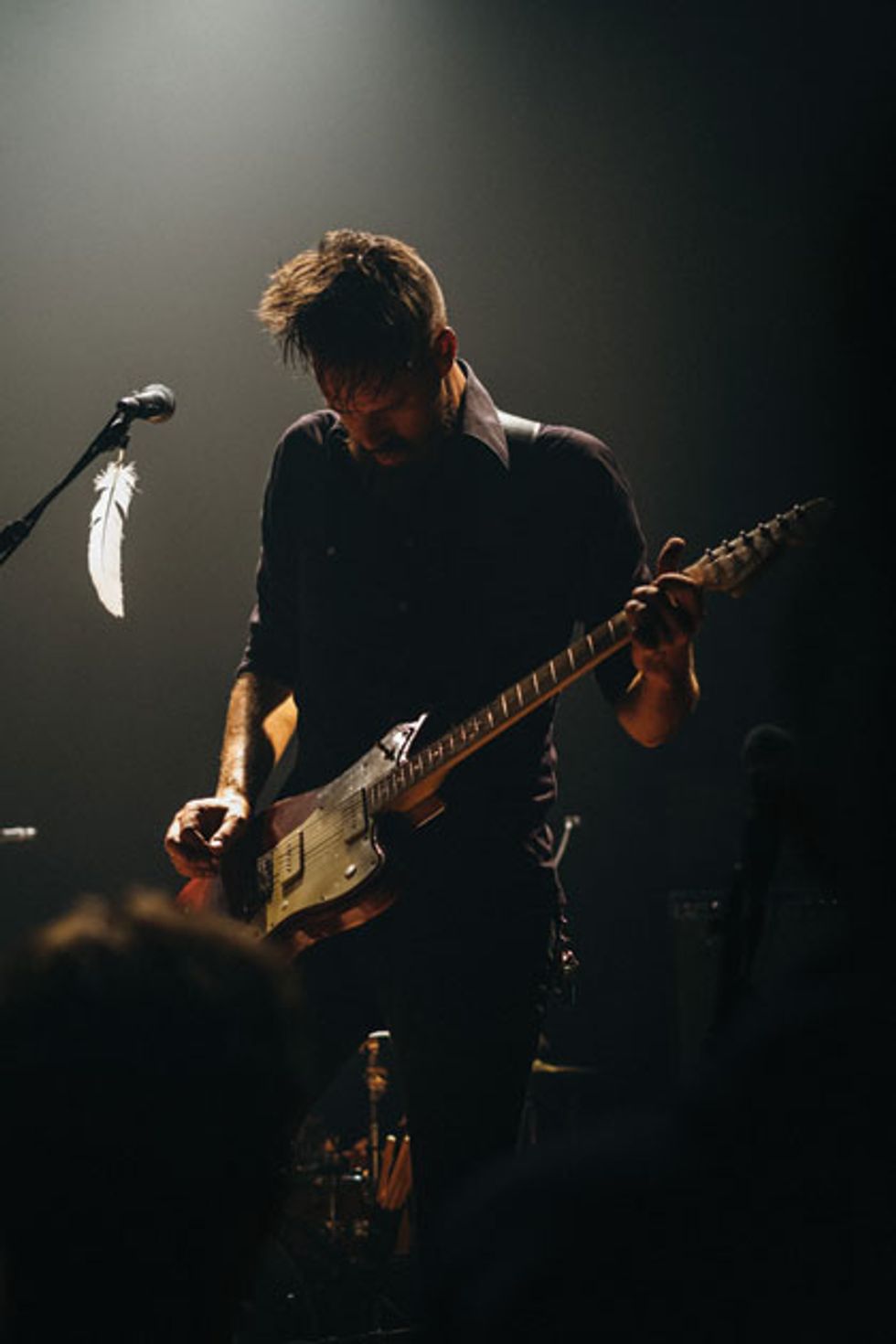A lot of guitar players talk about being “in the zone,” that extreme state of hyper-awareness in which focus and concentration take a backseat to instinct and intuition. For guitarists Philip Jamieson and Calvin Joss, founders of the Massachusetts-based post-rock instrumental band Caspian, being in the zone either onstage or in the rehearsal room sometimes goes one step further.
“There’s a bit of a trance thing that happens,” says Jamieson. “It’s really about us trying to bring in that element of sincerity and let our emotions come out. In order for us to get that across, we have to be in our right minds. Not to sound too New Age or spiritual or anything, but we have to be in touch with ourselves. You can’t fake it.”
“When you’re present and in the moment, it’s easy to be expressive,” Joss explains. “I think you’ve got to be vulnerable, and that allows you to be genuine. For us, it’s not about playing every note, but it’s about how you play them. That’s the expressiveness that comes out in your playing. And if it’s true, you don’t have to think about it.”
A sustained state of cosmic consciousness permeates the 10 tracks on Caspian’s recently released fourth studio album, Dust and Disquiet, on which Jamieson and Joss, along with bandmates Erin Burke-Moran and Jonny Ashburn (guitars), Jani Zubkovs (bass), and Joe Vickers (drums) explore the depths of their four-guitar “wall of sound” approach and come up with something that resembles metaphysical mood music. Produced by Matt Bayles (who helmed the group’s previous record, Waking Season), the set includes extreme grinders (“Arcs of Command”), proggy soundscapes (“Echo and Abyss”), and electronic-tinged epics (“Darkfield”), but also throws listeners a curve with Joss’ emotive, Neil Young-like vocals on the delicate acoustic folk ballad “Run Dry.”
“We definitely took some chances on the record,” says Jamieson, who admits to using 11 months to write and demo “Arc of Command” alone. “Matt was again the perfect producer for us. He’s an excellent traffic cop. He helps split up the division of labor and keeps things rolling smoothly. We have a lot of respect for him, so if he says, ‘Jump,’ we say, ‘How high?’’’
Jamieson and Joss both expanded on how high they jumped creatively during their chat with Premier Guitar—a spirited conversation in which they also dissected the ways they sculpt Caspian’s massive guitar sound, how they shed their shredder pasts, and the thought process the band went through following the unexpected death of founding bassist Chris Friedrich in 2013.
Some have described your music as “shoegaze,” although I hardly think that term applies to your live shows, which are energetic and athletic. Do you mind the tag?
Jamieson: No, I don’t mind it at all. A lot of the music that I grew up listening to was shoegaze music. I think you can apply it to us just because of the general murky atmosphere that we go for within the wall of sound. Physically, the show is much more of an in-your-face visceral experience than a real shoegaze thing.
Joss: Shoegazer rock isn’t taboo terminology. There’s definitely a lot of My Bloody Valentine—tons and tons of layered-guitar stuff. Phil’s into a lot of noise stuff. I think our individual influences really shape our playing. We’ve just found a way to all work together.

Guitarist Calvin Joss. Photo by Marc LeMoine
Not to dwell on Chris’ death, but how long did it take you guys to start functioning as a band again after he passed away?
Joss: We played a show that he had set up—it happened to be the same day as his funeral. I think it was a nice ode. For us, it was obviously super-cathartic. Later on, we had some meetings and talked about stuff. I think we all knew that we wanted to keep making music, and that it was the right thing to do.
Jamieson: We didn’t really pull up for air. We had a tour in the pipeline and I had already started demoing ideas for the record, so we kind of kept our heads down. We knew that we were going to press forward. It was almost an unspoken thing. And Chris would have wanted us to keep going.
Was there ever a time during your teens when you wanted to be shredders?
Joss: Oh, for sure. Growing up and learning to play guitar, I was into all the jam bands, and they had amazing virtuoso guitarists. I was into the Allmans and the Dead, Phish, and all that stuff. There was a time when I wanted to play faster and faster, but eventually I went in a different direction.
Jamieson: I was never into the Steve Vai super-shredder stuff. I guess I liked things infused with a bit more of that blues crunch. I picked up a guitar when I was 14. A buddy gave me a VHS copy of Led Zeppelin’s The Song Remains the Same. I remember popping the video in and seeing Jimmy Page play “Since I’ve Been Loving You.” I was in complete awe—chills down my spine. I was like, “I wanna get a Les Paul.”
Sure enough, the next week I went out and bought a Les Paul Studio. For pretty much all of high school, I wanted to be Jimmy Page. I was playing with super-light strings, and I was doing a lot of bendy stuff, and I was starting to explore blues music.
Which is interesting, because I don’t hear much of a blues influence in Caspian.
Jamieson: Oh, there’s hardly any!
What contributed to that seismic shift, where you went from blues-oriented rock to post-rock noise bands?
Jamieson: That “Eureka!” moment came when I went from Zeppelin to Godspeed You! Black Emperor. That was around 2002, when I randomly picked out one of their records on a blind buy. When I heard that record, it 100 percent changed my life. In terms of my approach to the guitar, it took a while for me to shed some of those frontman desires—the guy with the foot on the monitor. It was an unlearning curve. Then I met Cal, who was sort of already on that train. We started fleshing out guitar ideas together around that time, and in 2004 we started the band.
One thing led to another and I sort of ended up not defacing that part of myself. I was simply exploring new things. Then when we added a third guitarist in 2008, it was about taking a step back even more. It became less about me and more about the greater good.
“When you’re present and in the moment, it’s easy to be expressive,” Calvin Joss explains. “I think you’ve got to be vulnerable, and that allows you to be genuine. Photo by Ian Doreian
What was your trial-and-error process with effects—learning to use them as musical instruments?
Jamieson: When I started playing, it was a Tube Screamer, an amp, and a guitar. In 2002, I was in a band with three other guys. We were kind of doing an alt-rock indie thing—singer, choruses, bridges. Then there was a stretch in that band when the bass player and the singer didn’t show up for practice. The drummer and I would be hanging out, and I got my hands on a second Line 6 DL4, so I had two of those going. That’s when I learned how to loop things. The drummer and I would be in a basement for seven or eight hours with a couple of cases of beer, a couple Line 6 DL4s, and we had a blast looping up all of these sounds and creating this wall of sound. That’s when I learned you could stack sounds on top of each other.
Joss: Phil has always pushed the soundscape envelope for us. When we started out, we had some overlapping musical influences, but he’d always show me a bunch of soundscapey stuff that I hadn’t heard before, and I was like, “Wow, that’s really crazy.” He would set up all the intros for the songs, and then the whole band would play over the top of it. He’s refined that process.
Because you have so many guitarists and you don’t fit the traditional paradigm of rhythm guitarist/lead guitarist, is it ever like herding cats? How do you avoid this big guitar pile-on?
Jamieson: We’re very lucky. None of us overplays, and all of us have distinct approaches to tone, sound, and melodies. It just works together. We’re unified by our desire to sound massive. When we’re writing or demoing stuff, a lot of it’s really unspoken. We don’t communicate a ton, we just get in and do it.
Philip Jamieson’s Gear
GuitarsFender Jazzmaster clone built from stock parts
Fender Classic Player Jazzmaster
Fender Telecaster Deluxe
Gibson Les Paul Classic
Gibson ES-335
Amps
Fender ’65 Twin Reverb
Marshall 4x12 with 25-watt Celestion Greenbacks
Ampeg SVT 7PRO
Mesa/Boogie Dual Rectifier
Effects
Strymon blueSky reverb
Strymon El Capistan dTape Echo
Line 6 DL4 delay modeler
TC Electronic PolyTune
Electro-Harmonix Voice Box
Boss RC-20 Loop Station
TC Electronic Spark Booster
Two Boss DD-7 digital delays
MXR M116 Fullbore Metal Distortion
Fulltone OCD
Voodoo Lab Sparkle Drive
Ernie Ball VP Jr. volume pedal
Boyd custom stutter/kill switch
Strings and Picks
GHS Boomer light gauge (.010 .046)
Dunlop .73 mm
Calvin Joss’ Gear
GuitarsFender reissue ’72 Telecaster Thinline
Gibson EC-30 Blues King Electro
Hohner dreadnought (for “Run Dry”)
Carter pedal steel Mesa/Boogie Lonestar 2x12 combo
Effects
Dunlop volume pedal
Boss DD-5 Digital Delay
Ibanez TS9 Tube Screamer
Line 6 DL4 Delay Modeler
Dunlop TS1 Stereo Tremolo
Danelectro Daddy O overdrive
Akai Head Rush E2 delay
Strymon blueSky reverb
Boss TU-2 tuner
Strings and Picks
Ernie Ball Regular Slinky or GHS Boomers (.010-.046)
Dunlop nylon .60 mm
Joss: Phil and I have always had a natural chemistry. Like you said, it’s not really a rhythm or a lead thing, it’s very much guitar interplay
between the two. I used to talk about it as “I originally build the walls, and he paints them.”
When Aaron joined the band around 2007 or so, it took him a while to find his voice, to feel comfortable, and to build on what we were doing. It’s a big thing, learning how we all move, what we all do, and figuring out how to inhabit our space. Also, like for Phil and I, it was about learning to do less, which is really hard.
Cal, you stopped actively performing with the band some years ago, although you do make live appearances from time to time.
Joss: Yeah, after I got married, I bought a house, had two kids … a lot changed. I had a mortgage and different responsibilities. And there was a period when I didn’t know how to interact personally with the band. We had to figure out how to make things work. Thank goodness Erin and Jonny joined. Things started getting easier and, I have to say, my bandmates have been really helpful. I’m so grateful to them—they’ve kept me involved in the writing process. I try to get out and do shows with them when I can, but it’s just not always possible. As my kids get older, hopefully, I can do a lot more shows.
Your fans might be very surprised to hear an acoustic vocal song on Dust and Disquiet. Was “Run Dry” written as such?
Joss: It definitely was something I wanted to try. Once we had three-quarters of the album written, and we essentially knew the progression of songs and where the holes were, we started thinking of how to fill those spaces. We had “Echo and Abyss,” which is pretty intense, and then we had this idea for a really simple acoustic song that would go after it—a juxtaposition. I demoed a version of the song with some vocals, and I sent it to the guys to talk about.
At the same time, Erin and I were talking about vocals for “Echo and Abyss.” They’re on there. I feel like the vocals that I did on “Run Dry” influenced the idea of putting vocals out there. We pushed each other in that direction.
Jamieson: We’ve always wanted to have something like that on a Caspian album, but it never seemed to work out. We thought we might burn some bridges with some people—“You guys need to be an instrumental post-rock band”—but everyone’s received it with open arms. I think people are growing with us, and they want to keep moving forward. We have every intention of following that thread, I think, with future stuff. It keeps us excited.
In “Rioseco,” you have the big walls of sound, but you also have quiet walls of sound. What goes into forming the latter approach?
Jamieson: The layers are really important with that stuff, because, just to get nerdy, I think longer delay trails and a high mix level on your delay pedal will obscure a bit of the intimacy of a song. So it’s sort of rolling back that stuff in songs like “Rioseco” and not putting it as blatantly as “Here’s a delay pedal.”
For that song, there was definitely a compartmentalization. On this record I used a lot of the “warble box”—that’s our slang for the Strymon El Capistan—for that fractured, analog tape-sounding simulator thing. That really helped spread a lot of the parts. It fills a frequency range that allows Cal’s more sparkly stuff to stick out.
Caspian’s Dust and Disquiet includes extreme grinders, proggy soundscapes, and electronic-tinged epics, but also throws listeners a curve with the delicate acoustic folk ballad “Run Dry.” Photo by Igor Kasyanuk
In “Dust and Disquiet,” there’s a section in the middle where the noise is less like guitars and more like actual white noise, but there’s still a musicality to it. How do you arrive at that?
Joss: There are a lot of guitars. There are strings in that section and all of these washing cymbals.
Jamieson: Then there’s a piano part that runs prior to that, and it introduces a really soft melody. That has an upward trajectory. Then when it hits that sort of collapse spot, I just went wild on the piano.
Joss: We’re making noise, but we’re also articulating notes at that point. That’s the only part in the whole song where I get really heavy in the distortion I’m using. Even at the peaky points of the end of the song, I’m playing with a lower-level distortion to give it more feeling, whereas the rest of the guys are playing with the heavier distortion, so they counter each other. I’m making more of the melody so it has a quieter, more mournful thing.
In “Arcs of Command,” am I hearing actual harmony lead guitar parts or is that done with effects?
Jamieson: Guitar-wise, that song was a monster. There are seven or eight guitars, all doing distinct, separate melodies and harmony parts. We volleyed little moments—it shifted from Jonny to Erin to me at a certain spot. We were all passing the ball around in a circle. We were going for something pretty bombastic. That was the first time I ever used a wah pedal. There’s a part maybe three quarters in where it’s just a whiteout sheet of noise, a total maelstrom, and I was like, “Oh, this finally works. Awesome.” It was nice to just cross that off the bucket list.
You guys don’t use a ton of guitars. Cal, you rely pretty much on a Fender ’72 Thinline Telecaster reissue.
Joss: Yeah, it’s not the original, which is too bad. It’s my main guitar. I did use an ES-335 that Phil borrowed for one or two tracks on the new record. The Thinline Tele has been my staple for a long time. I just really like the warmth that it adds. It’s been a good guitar for me. I keep my action kind of high. Being that it’s a semi-hollow, it’s got the warmth of my acoustic to a degree.
And Phil, you tend to favor your Jazzmaster that’s not really a Jazzmaster.
Jamieson: Crazy-ass thing right? It’s a Jazzmaster clone built from parts. The guy who built it plopped the Fender laminate logo on there, just for shits. He bought all the parts stock and put it together. It’s become my Excalibur. It was out of commission for a couple of years, so I brought it to a guy in Boston who does amazing work. Getting that P-90 high-output pickup in the bridge was just massive. I don’t know where that thing’s been all my life, but it’s huge and warm and creamy, and it takes effects so well. That guitar’s been an ongoing passion project of mine. I’m glad it’s back in the fold.
YouTube It
It’s a sea of pedalboards as Caspian goes for the six-man assault (with Calvin Joss in tow) during this raucous, decidedly “un-shoegazer” three-song opener at the Larcom Theatre in their hometown of Beverly, Massachusetts, in 2014.
You both use a lot of effects, but what’s the one pedal you can’t live without?
Jamieson: Probably my Strymon El Capistan, for this record especially. I’m not using it as a delay, though. I’m just using it as a tape simulator, more or less. I wanted that to be my signature sound for this record. I was looking for something that I hadn’t heard a lot in this music, and that also got me excited about playing the guitar. It’s like nostalgia in a box.









![Rig Rundown: Russian Circles’ Mike Sullivan [2025]](https://www.premierguitar.com/media-library/youtube.jpg?id=62303631&width=1245&height=700&quality=70&coordinates=0%2C0%2C0%2C0)






















![Rig Rundown: AFI [2025]](https://www.premierguitar.com/media-library/youtube.jpg?id=62064741&width=1245&height=700&quality=70&coordinates=0%2C0%2C0%2C0)




















 Zach loves his Sovtek Mig 60 head, which he plays through a cab he built himself at a pipe-organ shop in Denver. Every glue joint is lined with thin leather for maximum air tightness, and it’s stocked with Celestion G12M Greenback speakers.
Zach loves his Sovtek Mig 60 head, which he plays through a cab he built himself at a pipe-organ shop in Denver. Every glue joint is lined with thin leather for maximum air tightness, and it’s stocked with Celestion G12M Greenback speakers.











